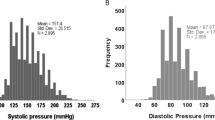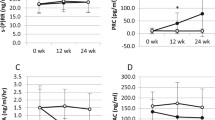Summary
It has been established that angiotensin II stimulation may limit the antihypertensive potential of diuretic therapy in some patients. It is less clear, however, whether renin-angiotensin II stimulation is the cause of the flat blood pressure dose-response relationship to diuretics. To investigate this, 75 out-patients with essential hypertension were treated with chlorthalidone 12.5, 25 or 50 mg o.d. for 3 weeks, in a double-blind, placebo controlled cross-over study.
Chlorthalidone significantly reduced blood pressure in all the groups, a plateau being reached at 25 mg o.d. Similarly, plasma renin activity was increased by each dose level of chlorthalidone, but it showed a different trend, being increased to a comparable extent at 12.5 mg and 25 mg o.d., and still higher at 50 mg o.d. Thus, greater stimulation of renin was coincident with the levelling of the blood pressure response to chlorthalidone. However no significant correlation was found between interindividual plasma renin activity and change in blood pressure, either in the entire series, or in each treatment subset.
The data suggest overall that renin stimulation may influence the characteristic dose-hypotensive response relationship to diuretic agents in antihypertensive therapy, but it is unlikely that measurement of individual plasma renin activity will provide an useful guide to the optimal dose of a diuretic agents.
Similar content being viewed by others
References
Bengtsson C, Johnsson G, Sannerstedt R, Werko L (1975) Effect of different doses of chlorthalidone on blood pressure, serum potassium and serum urate. Br Med J 1: 197–199
Berglung G, Andersson O (1976) Low dose of hydrochlorothiazide in hypertension. Antihypertensive and metabolic side-effects. Eur J Clin Pharmacol 10: 177–182
Tweedale MG, Ogilvie RI, Ruedy J (1977) Antihypertensive and biochemical effects of chlorthalidone. Clin Pharmacol Ther 22: 519–527
Materson BJ, Oster JR, Michael UF, Bolton SM, Burton ZC, Stambaugh JE, Morledge J (1978) Dose response to chlorthalidone in patients with hypertension. Clin Pharmacol Ther 24: 192–198
Russel JG, Mayhew SR, Humphries IS (1981) Chlorthalidone in mild hypertension. Dose-response relationship. Eur J Clin Pharmacol 20: 407–411
MacGregor GA, Markandu ND, Banks RA, Bayliss J, Roulston JE, Jones JC (1982) Captopril in essential hypertension: Contrasting effects of adding hydrochlorothiazide or propranolol. Br Med J 284: 693–696
MacGregor GA, Banks RA, Markandu ND, Bayliss J, Roulston J (1983) Lack of effect of beta-blocker on flat dose-response to thiazide in hypertension: Efficacy of low dose thiazide combined with beta-blocker. Br Med J 286: 1535–1538
Andersson GH, Dalakos TG, Eliss A, Tamycz N, Streeten DPH (1977) Diuretic therapy and response to saralasin. Ann Int Med 87: 183–187
Vaughan DE, Carey RM, Peach JM, Ackerly JA, Ayers CR (1978) The renin response to diuretic therapy. A limitation of antihypertensive potential. Circ Res 42: 376–381
Leonetti G, Terzoli L, Sala C, Bianchini C, Sernesi L, Zanchetti A (1978) Relationship between the hypotensive and renin-stimulating actions of diuretic therapy in hypertensive patients. Clin Sci 55: 307–309
Ibsen H, Leth A, Hollnagel H, Kappelgaard AM, Nielsen MD, Christensen NJ, Giese J (1979) Renin-angiotensin system in mild essential hypertension. Acta Med Scand 205: 547–555
Armitage P (1971) Statistical methods in medical research. Blackwell Scientific Publications, Oxford
Motolese M (1970) Un disegno fattoriale a blocchi bilanciati incompleti per la valutazione della dose minima attiva di un farmaco beta-bloccante. Boll Chim Farm 1–9, 363
Muiesan G, Sorbini CA, Grassi V, Solinas E, Casucci G, Petz E, Motolese M (1969) A controlled study of three respiratory stimulants in chronic respiratory failure. Dis Chest 55: 18
Malvano R, Zucchelli GC, Rosa U, Salvetti A (1972) Measurement of plasma renin activity by angiotensin I radioimmunoassay: (I) An assessment of some methodological aspects. J Nucl Biol Med 16: 24–30
Malvano R, Orlandini S, Cozzani P, Duranti P, Simonini N, Salvetti A (1976) Methodological simplifications in radioimmunoassay of urinary aldosterone. Clin Chim Acta 66: 331–337
Weber MA, Drayer JI, Rev A, Laragh JH (1977) Disparate patterns of aldosterone response during diuretic treatment of hypertension. Ann Int Med 87: 558–563
Salvetti A, Arzilli F, Poli L, Pedrinelli R, Sassano P, Motolese M (1978) Effects of therapy on the renin-angiotensin aldosterone system of hypertensive patients. In: James VHT, Serio M, Giusti C, Martini L (eds) The endocrine function of human adrenal cortex. Academic Press, London New York, pp 431–456
Roos JC, Baer P, Koomans HA, Geyskes GG, Darhout Mees EJ (1981) Haemodynamic and hormonal changes during acute and chronic diuretic treatment in essential hypertension. Eur J Clin Pharmacol 19: 107–112
Keeton KT, Campbell WB (1981) The pharmacological alteration of renin release. Pharmacol Revs 31: 81–145
Brunner HR, Baer L, Sealey JE, Ledingham JGG, Laragh JH (1970) The influence of potassium administration and of potassium deprivation on plasma renin activity in normal and hypertensive subjects. J Clin Invest 49: 2128–2138
Dluhy RG, Axelrod L, Underwood RH, Williams GH (1972) Studies of the control of plasma aldosterone concentration in normal man. J Clin Invest 51: 1950–1956
Keim HJ, Drayer JI, Thurston H, Laragh JH (1976) Triamterene induced changes in aldosterone and renin values in essential hypertension. Arch Int Med 136: 645–648
Pollavini G, Comi D, Grillo C, Lombardo M, Mantero O, Minetti L, Selvini A, Suppa G (1984) Effects of moderate salt restriction in hypertensive patients treated with oxprenolol or chlorthalidone. Int J Clin Pharmacol 22: 451–455
Author information
Authors and Affiliations
Additional information
The following Centres took part in the multicentre study (Investigator, Co-Investigator):1Pisa;2Pistoia (G. Bartolomei, G. Pettinà, F. Innocenti);3Pontedera (M.A. Cagianelli, M. Cipriani);4San Miniato (G. Cinotti);5Carrara (P. Innocenti, M. Diamanti);6Castelnuovo G. (C. Loni, F. Bianchini);7Seravezza (G. Saba);8Pescia (P. Saba, F. Giuntoli);9Volterra (L. Papi);10Roma, Ciba-Geigy Medical Department (M. Montanari)
Rights and permissions
About this article
Cite this article
Salvetti, A., Pedrinelli, R., Bartolomei, G. et al. Plasma renin activity does not predict the antihypertensive efficacy of chlorthalidone. Eur J Clin Pharmacol 33, 221–226 (1987). https://doi.org/10.1007/BF00637552
Received:
Accepted:
Issue Date:
DOI: https://doi.org/10.1007/BF00637552




